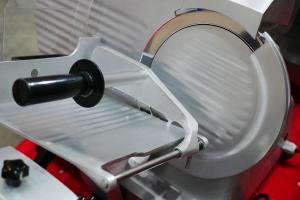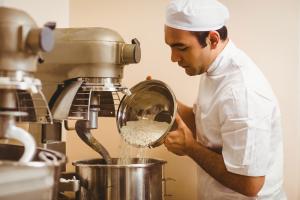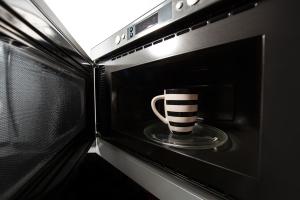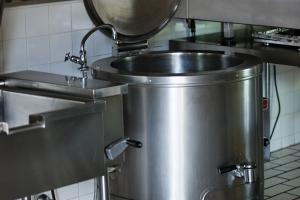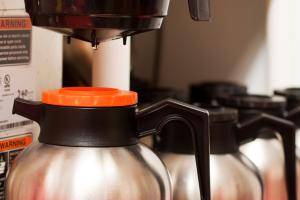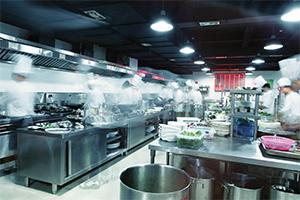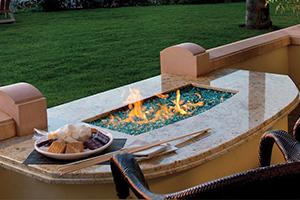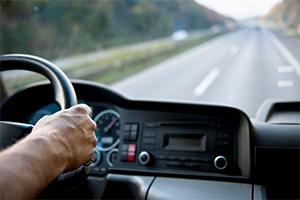Restaurant kitchen equipment safety
Below is important information for kitchen staff about the hazards associated with slicers, dicers, choppers, mincers, mixers, microwaves, steamers, pressure cookers and coffee makers. It's important to remember that child labor laws do not permit employees younger than 18 to work with, repair, adjust, or clean power-driven machinery like meat slicers and bakery mixers.
Possible solutions
Employers have the primary responsibility for protecting the safety and health of their workers. Employees are responsible for following the safe work practices of their employers.
Before operating any machinery workers should:
- Get trained in its use.
- Wear any personal protective equipment provided by the employer.
- Use any machine guarding provided.
- Always ask for help if unsure how to do something.
- Be aware that age restrictions exist for workers under the age of 18 from using or cleaning certain equipment.
- Follow the manufacturer’s instructions for machine use and cleaning.
Follow the general recommendations below to identify and avoid potential hazards associated with kitchen machinery.
Mincers, choppers, dicers and slicers
- Always use push sticks or tamps to feed or remove food from these types of machines.
- Do not use hands to feed smaller pieces of meat through slicers.
- Be sure to use any machine guarding that is provided to prevent access to cutter blades. Do not bypass safety guards.
- Do not open up or put hands into an operating machine to stir contents or guide food.
- Turn off and unplug the machine before disassembling and cleaning.
Food processors and mixers
- Do not attempt to remove items (for example, a spoon that falls into the mixture) from dough while the machine is mixing.
- Do not open up the lids of processors to stir contents while food is processing.
- Make sure the processor is off before opening the lid or adding items.
- Turn off and unplug machinery before cleaning or removing a blockage.
- Use any machine guards provided.
- Do not wear loose clothing or jewelry that could become caught in machinery.
Microwaves
- Make sure the microwave is located at approximately waist level and within easy reach, to provide for ease in the lifting of hot foods.
- Follow manufacturer’s instructions for operating microwave ovens.
- Cover foods cooked in microwaves to avoid splattering.
- Use caution when opening tightly covered containers. Open containers away from the face because they may be under pressure and could be extremely hot.
- Use appropriate personal protective equipment, such as hot pads when removing foods from microwave.
- Make sure door seals are in good condition and free from food or grease buildup.
- Do not use a microwave if it has a door that is damaged or doesn’t lock properly. Damaged ovens may emit harmful radiation.
- Do not microwave metals, foil, or whole eggs.
- Keep the interior of the microwave clean to avoid splattering and popping.
- If you notice any sparking inside the microwave, immediately turn off the microwave, unplug it, report it to the supervisor, and do not use it.
- Be advised that microwaves may interfere with the workings of pacemakers.
- Be aware that food cooked in the microwave can remain hot long after the microwave turns off.
Steamers
- Do not open the door while the steamer is on. Shut off the steamer and then wait a few minutes before releasing the pressure and opening.
- Clear the area around the steamer before opening.
- Open the steamer door by standing to the side, keeping the door between the operator and the open steamer.
- Use oven mitts to remove hot trays from the steamer.
- Place hot, dripping steamer trays on a cart to transport. If trays are carried by hand, they could drip on floors and create a slip hazard.
- If a steamer is stacked, remove the tray from the top steamer first, then the lower one, to prevent burns from rising steam.
Pressure cookers
- Shut off the steam supply and wait for the pressure to equalize before opening the lid of the pressure cooker.
- Stand to the side and open the pressure cooker away from yourself, keeping the open lid between you and the pressure cooker.
Coffee makers
- Do not place hot coffee makers close to the edge of counters where people passing by may come in contact with them.
- Check to make sure the coffee filter is in place before making any coffee.
- Do not remove the filter before the coffee has stopped dripping.
- Never stick fingers into the chamber of a coffee grinder to get beans to drop into the grinder. Tapping on the outside of the container will encourage beans to drop into grinder.
Source: U.S. Dept. of Labor, www.osha.gov
This material is provided for informational purposes only and does not provide any coverage or guarantee loss prevention. The examples in this material are provided as hypothetical and for illustration purposes only. The Hanover Insurance Company and its affiliates and subsidiaries (“The Hanover”) specifically disclaim any warranty or representation that acceptance of any recommendations contained herein will make any premises, or operation safe or in compliance with any law or regulation. By providing this information to you. The Hanover does not assume (and specifically disclaims) any duty, undertaking or responsibility to you. The decision to accept or implement any recommendation(s) or advice contained in this material must be made by you.
LC DEC 2018 08-70
171-0872 (01/14)
Related resources
Restaurant kitchen equipment safety
Below is important information for kitchen staff about the hazards associated with slicers, dicers, choppers, mincers, mixers, microwaves, steamers, pressure cookers and coffee makers. It's important to remember that child labor laws do not permit employees younger than 18 to work with, repair, adjust, or clean power-driven machinery like meat slicers and bakery mixers.
Possible solutions
Employers have the primary responsibility for protecting the safety and health of their workers. Employees are responsible for following the safe work practices of their employers.
Before operating any machinery workers should:
- Get trained in its use.
- Wear any personal protective equipment provided by the employer.
- Use any machine guarding provided.
- Always ask for help if unsure how to do something.
- Be aware that age restrictions exist for workers under the age of 18 from using or cleaning certain equipment.
- Follow the manufacturer’s instructions for machine use and cleaning.
Follow the general recommendations below to identify and avoid potential hazards associated with kitchen machinery.
Mincers, choppers, dicers and slicers
- Always use push sticks or tamps to feed or remove food from these types of machines.
- Do not use hands to feed smaller pieces of meat through slicers.
- Be sure to use any machine guarding that is provided to prevent access to cutter blades. Do not bypass safety guards.
- Do not open up or put hands into an operating machine to stir contents or guide food.
- Turn off and unplug the machine before disassembling and cleaning.
Food processors and mixers
- Do not attempt to remove items (for example, a spoon that falls into the mixture) from dough while the machine is mixing.
- Do not open up the lids of processors to stir contents while food is processing.
- Make sure the processor is off before opening the lid or adding items.
- Turn off and unplug machinery before cleaning or removing a blockage.
- Use any machine guards provided.
- Do not wear loose clothing or jewelry that could become caught in machinery.
Microwaves
- Make sure the microwave is located at approximately waist level and within easy reach, to provide for ease in the lifting of hot foods.
- Follow manufacturer’s instructions for operating microwave ovens.
- Cover foods cooked in microwaves to avoid splattering.
- Use caution when opening tightly covered containers. Open containers away from the face because they may be under pressure and could be extremely hot.
- Use appropriate personal protective equipment, such as hot pads when removing foods from microwave.
- Make sure door seals are in good condition and free from food or grease buildup.
- Do not use a microwave if it has a door that is damaged or doesn’t lock properly. Damaged ovens may emit harmful radiation.
- Do not microwave metals, foil, or whole eggs.
- Keep the interior of the microwave clean to avoid splattering and popping.
- If you notice any sparking inside the microwave, immediately turn off the microwave, unplug it, report it to the supervisor, and do not use it.
- Be advised that microwaves may interfere with the workings of pacemakers.
- Be aware that food cooked in the microwave can remain hot long after the microwave turns off.
Steamers
- Do not open the door while the steamer is on. Shut off the steamer and then wait a few minutes before releasing the pressure and opening.
- Clear the area around the steamer before opening.
- Open the steamer door by standing to the side, keeping the door between the operator and the open steamer.
- Use oven mitts to remove hot trays from the steamer.
- Place hot, dripping steamer trays on a cart to transport. If trays are carried by hand, they could drip on floors and create a slip hazard.
- If a steamer is stacked, remove the tray from the top steamer first, then the lower one, to prevent burns from rising steam.
Pressure cookers
- Shut off the steam supply and wait for the pressure to equalize before opening the lid of the pressure cooker.
- Stand to the side and open the pressure cooker away from yourself, keeping the open lid between you and the pressure cooker.
Coffee makers
- Do not place hot coffee makers close to the edge of counters where people passing by may come in contact with them.
- Check to make sure the coffee filter is in place before making any coffee.
- Do not remove the filter before the coffee has stopped dripping.
- Never stick fingers into the chamber of a coffee grinder to get beans to drop into the grinder. Tapping on the outside of the container will encourage beans to drop into grinder.
Source: U.S. Dept. of Labor, www.osha.gov
This material is provided for informational purposes only and does not provide any coverage or guarantee loss prevention. The examples in this material are provided as hypothetical and for illustration purposes only. The Hanover Insurance Company and its affiliates and subsidiaries (“The Hanover”) specifically disclaim any warranty or representation that acceptance of any recommendations contained herein will make any premises, or operation safe or in compliance with any law or regulation. By providing this information to you. The Hanover does not assume (and specifically disclaims) any duty, undertaking or responsibility to you. The decision to accept or implement any recommendation(s) or advice contained in this material must be made by you.
LC DEC 2018 08-70
171-0872 (01/14)
Related resources
Restaurant kitchen equipment safety
Below is important information for kitchen staff about the hazards associated with slicers, dicers, choppers, mincers, mixers, microwaves, steamers, pressure cookers and coffee makers. It's important to remember that child labor laws do not permit employees younger than 18 to work with, repair, adjust, or clean power-driven machinery like meat slicers and bakery mixers.
Possible solutions
Employers have the primary responsibility for protecting the safety and health of their workers. Employees are responsible for following the safe work practices of their employers.
Before operating any machinery workers should:
- Get trained in its use.
- Wear any personal protective equipment provided by the employer.
- Use any machine guarding provided.
- Always ask for help if unsure how to do something.
- Be aware that age restrictions exist for workers under the age of 18 from using or cleaning certain equipment.
- Follow the manufacturer’s instructions for machine use and cleaning.
Follow the general recommendations below to identify and avoid potential hazards associated with kitchen machinery.
Mincers, choppers, dicers and slicers
- Always use push sticks or tamps to feed or remove food from these types of machines.
- Do not use hands to feed smaller pieces of meat through slicers.
- Be sure to use any machine guarding that is provided to prevent access to cutter blades. Do not bypass safety guards.
- Do not open up or put hands into an operating machine to stir contents or guide food.
- Turn off and unplug the machine before disassembling and cleaning.
Food processors and mixers
- Do not attempt to remove items (for example, a spoon that falls into the mixture) from dough while the machine is mixing.
- Do not open up the lids of processors to stir contents while food is processing.
- Make sure the processor is off before opening the lid or adding items.
- Turn off and unplug machinery before cleaning or removing a blockage.
- Use any machine guards provided.
- Do not wear loose clothing or jewelry that could become caught in machinery.
Microwaves
- Make sure the microwave is located at approximately waist level and within easy reach, to provide for ease in the lifting of hot foods.
- Follow manufacturer’s instructions for operating microwave ovens.
- Cover foods cooked in microwaves to avoid splattering.
- Use caution when opening tightly covered containers. Open containers away from the face because they may be under pressure and could be extremely hot.
- Use appropriate personal protective equipment, such as hot pads when removing foods from microwave.
- Make sure door seals are in good condition and free from food or grease buildup.
- Do not use a microwave if it has a door that is damaged or doesn’t lock properly. Damaged ovens may emit harmful radiation.
- Do not microwave metals, foil, or whole eggs.
- Keep the interior of the microwave clean to avoid splattering and popping.
- If you notice any sparking inside the microwave, immediately turn off the microwave, unplug it, report it to the supervisor, and do not use it.
- Be advised that microwaves may interfere with the workings of pacemakers.
- Be aware that food cooked in the microwave can remain hot long after the microwave turns off.
Steamers
- Do not open the door while the steamer is on. Shut off the steamer and then wait a few minutes before releasing the pressure and opening.
- Clear the area around the steamer before opening.
- Open the steamer door by standing to the side, keeping the door between the operator and the open steamer.
- Use oven mitts to remove hot trays from the steamer.
- Place hot, dripping steamer trays on a cart to transport. If trays are carried by hand, they could drip on floors and create a slip hazard.
- If a steamer is stacked, remove the tray from the top steamer first, then the lower one, to prevent burns from rising steam.
Pressure cookers
- Shut off the steam supply and wait for the pressure to equalize before opening the lid of the pressure cooker.
- Stand to the side and open the pressure cooker away from yourself, keeping the open lid between you and the pressure cooker.
Coffee makers
- Do not place hot coffee makers close to the edge of counters where people passing by may come in contact with them.
- Check to make sure the coffee filter is in place before making any coffee.
- Do not remove the filter before the coffee has stopped dripping.
- Never stick fingers into the chamber of a coffee grinder to get beans to drop into the grinder. Tapping on the outside of the container will encourage beans to drop into grinder.
Source: U.S. Dept. of Labor, www.osha.gov
This material is provided for informational purposes only and does not provide any coverage or guarantee loss prevention. The examples in this material are provided as hypothetical and for illustration purposes only. The Hanover Insurance Company and its affiliates and subsidiaries (“The Hanover”) specifically disclaim any warranty or representation that acceptance of any recommendations contained herein will make any premises, or operation safe or in compliance with any law or regulation. By providing this information to you. The Hanover does not assume (and specifically disclaims) any duty, undertaking or responsibility to you. The decision to accept or implement any recommendation(s) or advice contained in this material must be made by you.
LC DEC 2018 08-70
171-0872 (01/14)
Related resources
Restaurant kitchen equipment safety
Below is important information for kitchen staff about the hazards associated with slicers, dicers, choppers, mincers, mixers, microwaves, steamers, pressure cookers and coffee makers. It's important to remember that child labor laws do not permit employees younger than 18 to work with, repair, adjust, or clean power-driven machinery like meat slicers and bakery mixers.
Possible solutions
Employers have the primary responsibility for protecting the safety and health of their workers. Employees are responsible for following the safe work practices of their employers.
Before operating any machinery workers should:
- Get trained in its use.
- Wear any personal protective equipment provided by the employer.
- Use any machine guarding provided.
- Always ask for help if unsure how to do something.
- Be aware that age restrictions exist for workers under the age of 18 from using or cleaning certain equipment.
- Follow the manufacturer’s instructions for machine use and cleaning.
Follow the general recommendations below to identify and avoid potential hazards associated with kitchen machinery.
Mincers, choppers, dicers and slicers
- Always use push sticks or tamps to feed or remove food from these types of machines.
- Do not use hands to feed smaller pieces of meat through slicers.
- Be sure to use any machine guarding that is provided to prevent access to cutter blades. Do not bypass safety guards.
- Do not open up or put hands into an operating machine to stir contents or guide food.
- Turn off and unplug the machine before disassembling and cleaning.
Food processors and mixers
- Do not attempt to remove items (for example, a spoon that falls into the mixture) from dough while the machine is mixing.
- Do not open up the lids of processors to stir contents while food is processing.
- Make sure the processor is off before opening the lid or adding items.
- Turn off and unplug machinery before cleaning or removing a blockage.
- Use any machine guards provided.
- Do not wear loose clothing or jewelry that could become caught in machinery.
Microwaves
- Make sure the microwave is located at approximately waist level and within easy reach, to provide for ease in the lifting of hot foods.
- Follow manufacturer’s instructions for operating microwave ovens.
- Cover foods cooked in microwaves to avoid splattering.
- Use caution when opening tightly covered containers. Open containers away from the face because they may be under pressure and could be extremely hot.
- Use appropriate personal protective equipment, such as hot pads when removing foods from microwave.
- Make sure door seals are in good condition and free from food or grease buildup.
- Do not use a microwave if it has a door that is damaged or doesn’t lock properly. Damaged ovens may emit harmful radiation.
- Do not microwave metals, foil, or whole eggs.
- Keep the interior of the microwave clean to avoid splattering and popping.
- If you notice any sparking inside the microwave, immediately turn off the microwave, unplug it, report it to the supervisor, and do not use it.
- Be advised that microwaves may interfere with the workings of pacemakers.
- Be aware that food cooked in the microwave can remain hot long after the microwave turns off.
Steamers
- Do not open the door while the steamer is on. Shut off the steamer and then wait a few minutes before releasing the pressure and opening.
- Clear the area around the steamer before opening.
- Open the steamer door by standing to the side, keeping the door between the operator and the open steamer.
- Use oven mitts to remove hot trays from the steamer.
- Place hot, dripping steamer trays on a cart to transport. If trays are carried by hand, they could drip on floors and create a slip hazard.
- If a steamer is stacked, remove the tray from the top steamer first, then the lower one, to prevent burns from rising steam.
Pressure cookers
- Shut off the steam supply and wait for the pressure to equalize before opening the lid of the pressure cooker.
- Stand to the side and open the pressure cooker away from yourself, keeping the open lid between you and the pressure cooker.
Coffee makers
- Do not place hot coffee makers close to the edge of counters where people passing by may come in contact with them.
- Check to make sure the coffee filter is in place before making any coffee.
- Do not remove the filter before the coffee has stopped dripping.
- Never stick fingers into the chamber of a coffee grinder to get beans to drop into the grinder. Tapping on the outside of the container will encourage beans to drop into grinder.
Source: U.S. Dept. of Labor, www.osha.gov
This material is provided for informational purposes only and does not provide any coverage or guarantee loss prevention. The examples in this material are provided as hypothetical and for illustration purposes only. The Hanover Insurance Company and its affiliates and subsidiaries (“The Hanover”) specifically disclaim any warranty or representation that acceptance of any recommendations contained herein will make any premises, or operation safe or in compliance with any law or regulation. By providing this information to you. The Hanover does not assume (and specifically disclaims) any duty, undertaking or responsibility to you. The decision to accept or implement any recommendation(s) or advice contained in this material must be made by you.
LC DEC 2018 08-70
171-0872 (01/14)



